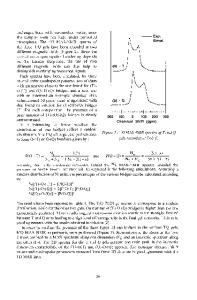Vibrational Spectroscopy and MAS NMR Studies of A Cryptomelane Family of Mixed ( 7 Li + , 2 H + ) Form Manganic Acids
- PDF / 108,552 Bytes
- 6 Pages / 595 x 842 pts (A4) Page_size
- 49 Downloads / 257 Views
DD11.8.1
Vibrational Spectroscopy and MAS NMR Studies of A Cryptomelane Family of Mixed (7Li+, 2H+) Form Manganic Acids Masamichi Tsuji, Younkee Paik1, Clare P. Grey1, and Satoshi Murao2 Tokyo Institute of Technology, Research Center for Carbon Recycling and Energy, Tokyo, JAPAN. 1Department of Chemistry, State University of New York at Stony Brook, Stony Brook, NY11794-3400, USA. 2National Institute of Advanced Industrial Science and Technology, Institute for Geo-resources and Environment, JAPAN.
ABSTRACT Cryptomelane-type manganic acids (CMAs) synthesized by a soft-chemical redox process of KMnO4 with MnSO4 in H2SO4 and α-MnO2s by a decomposition-oxidation process of (CH3)3COK and MnCO3 at 530oC were studied by using the vibrational spectroscopy and 7Li- and 2H-MAS NMR. The infrared absorption bands of the α-MnO s at 706cm-1 were not changed 2 irrespective of the sort of alkali cations and their uptake amount, while large shifts of this band were observed on the CMA exchanged by alkali cations. Hence, cation-exchange sites of these solids will occupy crystallographically different positions. 7Li-MAS NMR spectra of these manganic acids showed different two chemical shifts depending on their synthetic routes. These findings suggest that different ion-exchange sites are formed at a local level in the 2x2 type tunnel, strongly depending on their synthetic conditions. These are crucial for the control of the cation affinity. These details at a molecular level cannot be obtained by using the conventional XRD analyses.
INTRODUCTION A cryptomelane-type manganic acid (CMA) can be prepared by substituting H+ for alkali cations incorporated into MnO2 synthesized by the soft-chemical redox process using KMnO4 with MnSO4 in H2SO4 at 60oC [1-3]. The CMA has been recently discovered as an excellent solid extractant of Pb2+ from environmental aqueous effluents [4]. Affinity of the CMA for Pb2+ was extremely large as well as K+ and Rb+. It was ascribed to the electron configuration and the ion size fit for d-elements and p-elements, respectively. This high level of affinity could not be attained on α-MnO2 and hollandite-type MnO2 [5-7]. However, there is not a straightforward relation between the ion affinity and the crystal structure of solids, and hence it is not easy to predict the ion affinity from the crystal structure in the current level of science. Major reasons may be as follows. It is difficult to know the concentration of mobile charge even in a perfect crystal. Actual crystals synthesized using available techniques have several imperfections such as lattice defects, non-stoichiometry, and deformation of crystal. Hence, it is very important to minimize these imperfections by precisely regulating synthetic conditions in order to prepare solid extractants with high affinity for specified ions. Magic angle spinning (MAS) NMR and vibrational spectroscopy will provide helpful information indicating the chemical state around the ion-exchange sites. This
DD11.8.2
paper will describe vibrational spectroscopy and MAS NMR o
Data Loading...










